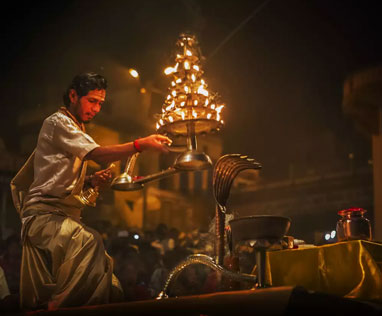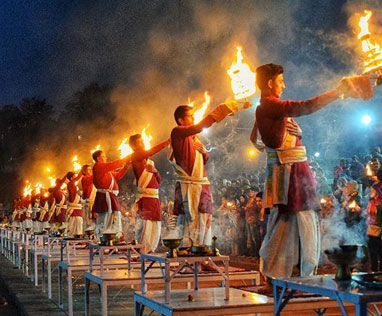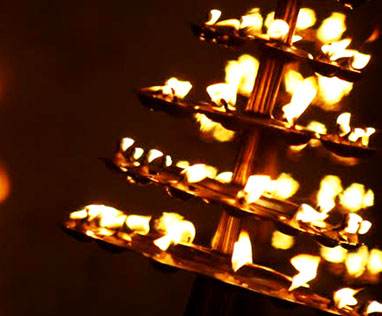Aarti (Hindi), also spelled arathi, aarthi (from the Sanskrit term Aradhana) is a Hindu ritual, in which light from wicks soaked in ghee (purified butter) or camphor is offered to one or more deities. Aartis also refer to the songs sung in praise of the deity, when offering of lamps is being offered.
In Sanskrit, the term aarti can be broken up into two words - "aa' meaning towards and "rati" meaning the highest love for God. Traditionally, aarati is done two or three times a day, at the conclusion of a puja, bhajan or havan.
It is a mandatory ritual performed on all auspicious occasions of Hindus. The aarti thali, which contains diya, flowers, incense and akshata, is circulated in front of the deity and arti song is sung by all members present there. When arti is performed before God, it is believed that the plate and the light get blessed by the deity.
The pandit, or the priest, passes on the arti plate from one person to another, present there, who cup the flickering fire lightly with their down-turned hands. Then, they put their hands over the flame and then touch their forehead, as a gesture of seeking holy blessings. The plate on which the aarati is performed is usually made of silver, bronze or copper.
Aarti is also performed in front of a person, either as a welcome gesture or to ward off bad influences from him. Infact, the whole purpose of arti is to ward off the evil spirits and bad omens.It is a greeting ceremony offered to the murti and also gurus, holy people, and other representations of the divine. Arti is often called "the ceremony of lights" but usually involves offering more than just a lamp.
The priest or worshipper offers various auspicious articles by moving them in clockwise circles before the deity. At the same time he or she rings a small hand bell, while meditating on the forms of the deity.During the entire ceremony, which normally lasts from five to thirty minutes, the worshipper offers incense, a flower, water, a five-wick lamp, a lamp with camphor and other items.
The ceremony is often announced and concluded by the blowing of a conch-shell.During the ceremony the offered lamp is passed around the congregation; members pass their fingers over the flame and reverently touch them to their foreheads. The offered flowers are also passed around worshippers and the water is sprinkled over their heads.Arti is usually accompanied by singing (bhajan/kirtan) and out of respect worshippers usually stand for the entire ceremony.



Aarti is said to have descended from the Vedic concept of fire rituals, or homa. The word may also refer to the traditional Hindu devotional song that is sung during the ritual. Aarti is performed and sung to develop the highest love for God. "Aa" means "towards or to", and "rati" means "right or virtue" in Sanskrit.
Aarti performed at South Indian temples mostly follows the above-mentioned rituals except that they are often more elaborate in the way they are performed. Aarti is also referred to as Deepa Aaradhanai in Tamil.